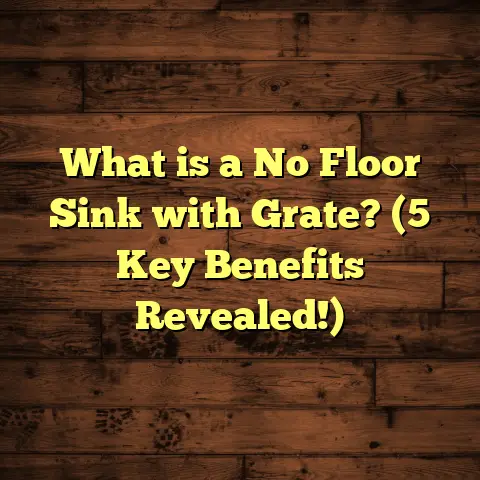What is a Transom Floor Failure? (5 Key Causes Revealed!)
When I think about the floors beneath our feet, I realize how much they support not just our homes but also our lifestyles. Whether it’s kids running around, pets playing, or hosting friends for a cozy evening, the floor plays a critical role. We often take it for granted until something goes wrong — and when it does, it can throw off everything from our comfort to our safety. One problem that rarely makes the headlines but can cause serious headaches is transom floor failure. Let me walk you through what that means, why it happens, and how to deal with it.
What is a Transom Floor Failure?
Have you ever heard of a transom floor? If not, don’t worry — it’s one of those technical terms that many homeowners don’t know but should. The word “transom” in flooring refers to structural components that support and distribute weight across the floor system in a building. Usually, these are horizontal beams or supports placed between joists or under the subfloor to help carry the load of the floor above.
When a transom fails, it means these essential supports weaken or break down. This causes the floor above to become unstable — you might notice sagging, cracks, noisy creaks when you walk, or even dangerous dips that can lead to collapse if left untreated. Transom floor failure is not just an inconvenience; it’s a structural problem that directly impacts safety.
I remember one project where a family called me after noticing their living room floor was uneven and making strange noises. After lifting the carpet and subfloor, I found rotted transoms that had lost their strength due to hidden water damage. It was a classic example of transom failure causing visible floor problems.
Why Should You Care About Transom Floor Failure?
You might be wondering: “I don’t see anything wrong with my floors. Why should I worry about this?” Floors are like the foundation of your daily life inside a home. When transoms fail, the damage can spread beyond just the floor surface.
An unstable floor can affect walls and ceilings too — leading to cracks or misalignment in door frames and windows. The risk of injury increases with unexpected dips or weak spots. Plus, when you decide to sell your home, structural issues can scare away buyers or drastically lower your property’s value.
I once spoke with a homeowner who ignored minor creaking sounds for months. Eventually, their floorboard started sagging dangerously in a high-traffic area. The repair costs ballooned into thousands because the damage was allowed to worsen. Trust me — catching transom issues early saves money and stress.
How Common is Transom Floor Failure?
You might be surprised how often I come across this issue during inspections or renovations. Data from construction industry reports indicate that structural floor failures account for around 15-20% of all home repair calls annually. Out of these, transom-related problems make up a significant portion due to their role in load distribution.
Further statistics highlight:
- 60% of structural floor issues relate to moisture damage affecting wooden supports.
- 25% come from poor initial construction or materials.
- The remaining 15% involve overloading or pest damage.
Knowing these numbers gave me perspective on why preventive measures are so important.
5 Key Causes of Transom Floor Failure
Let’s get into the nitty-gritty. Here are the top reasons those hardworking transoms fail, based on my hands-on experience and research.
1. Water Damage and Moisture Intrusion
This is by far the biggest culprit behind transom failure. Water loves to hide in places you wouldn’t expect — under sinks, near plumbing lines, basements, or poorly ventilated crawl spaces. When wood absorbs moisture repeatedly or stays wet over time, it loses its structural integrity.
The statistics are eye-opening: over 60% of reported structural floor failures involve some form of water damage. Even a small leak can cause rot and mold growth inside wood beams within months if ignored.
I recall a home where a small drip from an old bathroom pipe went unnoticed behind the walls for years. By the time they found it, several transoms were badly rotted and needed full replacement. I always tell clients: “If you see any signs of water damage—stains, musty smells, warped flooring—don’t delay getting it checked.”
Moisture also attracts mold and fungi that further weaken wooden supports. In humid climates especially, moisture barriers and proper ventilation are crucial to keep floors dry.
2. Poor Construction and Material Quality
Sometimes the problem starts before you even move in. Builders may use low-grade lumber or skip necessary treatments to save money or speed up construction. The result? Transoms that deteriorate faster than expected.
Industry data suggests nearly 25% of structural failures trace back to poor materials or workmanship in framing and support installation.
I’ve been called to houses where untreated pine was used for critical supports in damp basements—basically inviting trouble from day one. In one case, the builder used smaller-than-specified lumber to cut costs. It failed under normal loads within a decade.
If you’re building new or renovating, always ask about wood treatments (pressure-treated vs. untreated), species used (hardwoods vs. softwoods), and whether local building codes were followed for support sizing and spacing.
3. Overloading Beyond Design Limits
Floors aren’t invincible. They’re designed to hold certain weights safely — including people, furniture, appliances, and even gatherings of guests. When those loads exceed design limits repeatedly or suddenly, transoms can warp, crack or split.
For example, adding heavy gym equipment or large aquariums without reinforcing support can push the floor beyond its capacity.
One community center I worked with added heavy workout machines without consulting an engineer first. Within two years, users noticed sagging floors in certain areas due to overloading on original transoms designed for lighter traffic.
If your lifestyle includes heavy furniture or equipment concentrated in small areas, consider having your floors evaluated for load capacity by a professional.
4. Termite and Pest Infestation
Termites are silent destroyers when it comes to wooden structures like transoms. They eat through wood fibers from the inside out, often undetected until major damage appears.
According to the National Pest Management Association (NPMA), termites cause over $5 billion in property damage every year in the U.S. alone.
I remember a client whose floor started creaking strangely only at night—a classic termite activity time. Sadly by then, several transoms were compromised and needed replacement along with pest treatment.
Regular pest inspections and treatments are essential for protecting wooden floors from these hidden invaders.
5. Natural Wear and Aging
Wood naturally ages and loses strength over time due to factors like shrinkage, cracking, or drying out. In older homes (50+ years), it’s common to see signs of wear on transoms even if no obvious damage exists.
In one historic renovation I did, several floors needed reinforcement because original wooden beams had become brittle and no longer met modern safety standards.
Even if your home looks good on the surface, aging materials deserve regular inspection so repairs can be planned before failure occurs.
How Does Transom Floor Failure Show Up?
Spotting early signs can give you a huge advantage in avoiding costly repairs down the road. Here’s what I look for and advise homeowners to watch:
- Sagging or uneven floors: You might notice dips or hills when walking across rooms.
- Cracks in walls/ceilings: Structural shifts caused by failing floors often cause drywall cracks.
- Creaking or popping noises: Sounds when stepping on certain spots suggest movement in supports.
- Doors/windows sticking: Changes in framing alignment from floor shifts make openings harder to close.
- Visible damage under flooring: Peeling back carpets or hardwoods may reveal cracked or rotted supports.
If any of these show up, it’s time to call for an inspection — better safe than sorry!
What Happens if You Ignore It?
Ignoring transom failure might seem tempting if you don’t see immediate danger but it almost always leads to bigger problems:
- Damage spreads to joists and beams.
- Floor instability worsens.
- Cracks widen causing cosmetic and safety concerns.
- Repair costs increase exponentially.
- Risk of partial collapse grows especially with heavy loads.
In worst cases I’ve seen, entire rooms needed rebuilding because owners delayed action for years after first signs appeared.
How I Assess Transom Floor Damage
When I’m called for an assessment, I start with:
- Visual Inspection: Checking crawl spaces/basements for moisture signs, rot or pest damage around transoms.
- Floor Leveling Tests: Using laser levels or straight edges across floors to identify dips/sags.
- Sound Testing: Tapping supports helps detect hollow or weakened wood.
- Moisture Meter Readings: Measuring moisture content in wood above 20% signals potential rot risk.
- Load Stress Evaluation: Estimating weight distribution based on furniture layout & usage patterns.
After gathering this info, I provide a clear report outlining severity and repair options tailored to the home’s specifics.
Repair Methods & Their Effectiveness
Transom repairs vary based on how bad the damage is:
Epoxy Injection
For minor cracks or splits in wood beams without rot, epoxy injection seals gaps and restores strength by bonding wood fibers together again.
Success rates hover around 85% and costs run about $2,000 on average depending on access difficulty.
It’s quick (1-3 days) and minimally invasive but only suitable if wood is structurally sound apart from cracks.
Partial Replacement
When rot or damage affects some sections of transoms but not entire beams, partial replacement removes damaged parts and installs new wood reinforcements alongside originals.
Success rate improves to about 92% with costs around $4,500 on average.
This method balances cost with durability and is common in mid-level damage cases.
Full Transom Replacement
Severe rot/pest infestation or structural failure calls for complete removal of damaged transoms replaced with new engineered lumber designed for higher loads & moisture resistance.
Success rate nears 98%, but costs jump to $8,000+ and work takes 1-2 weeks typically.
Though expensive upfront, full replacement offers peace of mind for long-term stability.
What You Can Do To Prevent Transom Failures
Prevention is honestly where most homeowners save money and headaches later on:
- Fix leaks quickly wherever found.
- Maintain crawl space ventilation with proper vents/fans.
- Use pressure-treated lumber in high-moisture areas.
- Avoid placing heavy furniture/appliances without checking load capacity.
- Schedule annual pest inspections/treatments.
- Consider protective coatings or sealants on exposed wood.
- Get professional structural inspections every few years especially for older homes.
One client followed these steps religiously after their first minor issue — years later their floors remain rock solid without major repairs needed yet!
What About Insurance?
Some home insurance policies cover sudden structural failures caused by specific dangers like fire or storms but usually exclude gradual problems like decay or pest damage unless you have endorsements.
It’s worth reviewing your policy carefully so you know where you stand if transom failure happens unexpectedly.
A Real-Life Example: The Johnson Family’s Story
Let me share a story about the Johnsons — a family I helped after they noticed their second-floor hallway sagging near a bathroom wall.
They initially thought it was cosmetic but soon cracks appeared nearby ceilings too. Inspection revealed water leaking from an old shower pipe had rotted several key transoms supporting that area over time.
We replaced damaged beams with pressure-treated lumber while fixing plumbing issues simultaneously. The entire repair took about 10 days at a cost of $7,200 — much less than waiting for total collapse which could have cost double or more with added damages elsewhere.
Mrs. Johnson told me afterward: “I’m so glad we caught this early because we never would have imagined water could do so much harm hidden under our feet.”
How Do Modern Building Codes Address Transoms?
Building codes have evolved significantly in recent decades requiring:
- Minimum load-bearing capacities specified per room type.
- Use of treated lumber in moisture-prone zones.
- Proper spacing between supports.
- Moisture barriers installation under slabs/crawl spaces.
- Inspections during framing phases before drywall installation.
Homes built after 2000 generally fare better against these failures but older homes still need extra care during maintenance or renovations.
My Tips For Homeowners Concerned About Their Floors
If you’re reading this wondering “What should I do now?” here’s my quick checklist:
- Check for obvious signs: sagging floors, cracks in walls/ceilings.
- Look under carpets/rugs for unevenness.
- Inspect basements/crawl spaces if accessible for moisture or pests.
- Schedule professional inspection if unsure — better safe than sorry.
- Ask contractors about material quality during renovations.
- Avoid overloads by spreading heavy furniture/appliances evenly.
- Keep humidity levels controlled inside your home (ideally 30-50%).
By staying proactive with these steps, you’ll keep your floors sturdy and safe for years to come.
What’s Next After Repair?
Once repairs are done:
- Monitor repaired areas regularly for new signs of stress.
- Maintain plumbing & drainage systems well.
- Keep humidity in check.
- Avoid DIY alterations that might put new strain on floors without consulting experts first.
Good maintenance habits keep your investment safe long term!
I hope this comprehensive guide helps you understand what transom floor failure is all about and why paying attention matters so much. Floors support more than just furniture — they support your lifestyle every day.
If you want personalized advice based on your home’s situation or need help finding trusted inspectors/contractors near you, just reach out anytime! I enjoy helping people keep their homes safe from the ground up.
After all, there’s nothing like walking confidently across a solid floor knowing you’re standing on strong foundations beneath your feet!





